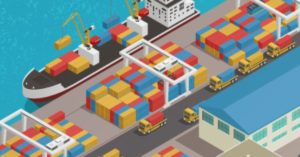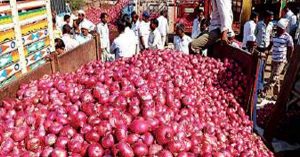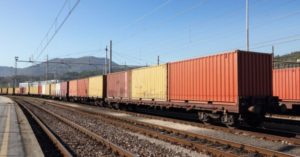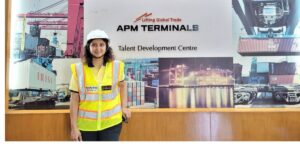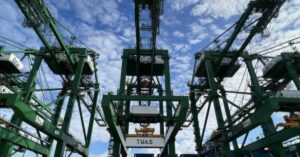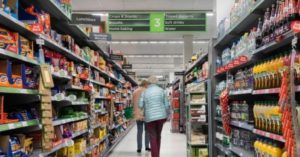It seems there is a lot of action happening at JNPT SEZ, you have recently inaugurated the coastal berth and electric vehicles are being used for transportation. So, let me begin by asking you very basic question like how is the business this year compared to last year. Now, we see that the pandemic is slightly opening up the markets and the impact is now lesser than compared to last year so in terms of business, how is JNPT?
So, as you all well know the background that due to the pandemic there have been supply chain disruptions and there was a demand contraction mainly in the first half of the last financial year and compared to the first wave where there was a huge contraction, this year, if at all, has been very marginally affected by the Covid. In fact, if we look at the figures and compare only up to July then the increase is as high as 60 per cent. Basically, what it means is that there was a huge contraction in the first quarter and in fact up to September, October last year.
After October, in fact, the turnaround was quite healthy and at the end of the year, the overall decrease was about -7 per cent. So, today when we talk, we not only have done more than the year before that. Basically, it means that if we compare it to a regular year, we are about 4 per cent to 5 per cent more of this. So, if you want to look at it like this, in a way, we could call it business as usual because it means that despite the disruptions last year, we have been able to overcome it now and currently the figures tell us that it is almost as a normal year.
That’s good to know. When it is business as usual, does it mean that you have the same shipping calls as last year, because we have seen during the pandemic some of the shipping lines have skipped JNPT due to shortage of exports, and now is normalcy restored in terms of calls?
Exactly, that’s what I said, in fact October onwards there was a semblance of normalcy and if you say, yes, some skips happen all the time. In that sense, when you say, in a normal year also, there could be some skips happening due to various reasons but pandemic as a background, overall economic uncertainty let’s say which was causing some of these things. When we talk about exports today and overall imports for JNPT, I think we are very much normal.
Let us talk about the most that is happening – the SEZ. Perhaps this is the first port-based SEZ and it is visualized to be a game changer in port-led development. So, what is the current status and what do you visualize once this SEZ becomes operational in terms of industries coming up. So, what is the vision for this SEZ?
So, as you yourself said, this is the first port-based SEZ of this scale and scope. We have completed the infrastructure of about 565 crores in fact which basically includes a very very good plug and play infrastructure including the roads, the water, the STP, the electricity and if you in fact, I will use this forum to invite all the stakeholders to come and visit the SEZ which is now ready for operation. In fact, when we say even when one unit gets operationalized, the SEZ is called operational.
So, here what has happened is over the last two years or so, the big investment that came in was for FTWZ that is the Free Trade Warehousing Zone by Hindustan Infralog Private Limited, which is basically the DP World people. So, 44 acres of land they are developing where roughly an area of 1,80,000 square metres is being developed for FTWZ. We have been taking out plots in trenches as per the demand and as per the market conditions. So, more than about 21 plots which went at one time now we are looking at providing more and more plots of varying sizes. The original ideation focused a little more on manufacturing. However, later on we have, as per the SEZ Act included all manufacturing and all services which are permitted which basically means that the export related warehousing, storage and all other services can also come in as per the requirement and demand which is a very evolving thing because when we link it to the port-related business, specific exporters have specific demands, so we have shown that kind of flexibility to provide plots of those sizes.
Also, have tenure of a nature which will help long-term investments. Now, we are also trying to encourage end-to-end kinds of solutions. There were people who need various kinds of certifications or value-added services that might include packaging, grading, sorting, irradiationin some cases especially because a lot of agri business happens from Maharashtra hinterland. So, these kinds of units and these kinds of facilities are coming up in the SEZ.
It’s definitely a game changer to the extent that for the first time, it provides a linkage to the bigger container port in the country which is just next to the port and the kind of time that people would factor in for getting in their exports would be curtailed in a very big way so that time and cost savings, both are huge and the land and the kind of infrastructure we are providing is very cost competitive.
When you say manufacturing and services at the SEZ, in terms of manufacturing, are there specific industries that are being targeted or are there any restriction or so on some of the sectors, like non-polluting?
Naturally, when we say all this is totally subject to the compliance of the Maharashtra Pollution Control Board or any other agency which has restrictions. From our side, as I said very clearly, SEZ Act provides for all kinds of industries and as I said manufacturing and services. From our side, there are no restrictions, however, these are subject to clearances which include consent to establish and consent to operate from the Maharashtra Pollution Control Board.
So, how is the response so far?
I would say that despite the Covid, when we took out 16 plots right now, we, barring one or two plots here and there, otherwise we got a good response. As I said, we are more open to now customizing the size, the tenure, etc. as per the demand of the potential stakeholders.
Let me move onto another topic that you have recently inaugurated the coastal berth. So, how is it being used?
As far as the coastal birth is concerned, again to put things in perspective there has been a huge push from the government of India to improve the share of the coastal trade. Basically, what it means is that the road and the rail that we have been using over the years, we definitely should look at this new mode which is hardly used in this country. So, as far as JNPT is concerned, till now, it has been a negligible portion of the various modes that we use. So, basically whatever evacuation happens from the port, it is mostly road and rail, and rail contributing to let’s say, 15 per cent to 16 per cent. In recent times, that’s increased a little to 17 per cent to 18 per cent but the coast has not contributed to that.
So, the government of India pushed this that we could have an exclusive facility for coastal movement and when we talk about coastal movement, in JNPT’s case we have a certain shallow water berth as you might be aware where we have been dealing with cement over the years but getting into a deep dive into this that we realize that there is a lot of scope for a commodity like steel for example which we have not been doing and typically, the example given is that from Mumbai to JNPT, if we were to be doing some coastal movement, we could be saving a lot of congestion on Mumbai and Thane roads. There is a lot of Mumbai-bound traffic for example which takes the roads and goes up to Bhiwandi and then comes back again which basically means that a lot of this kind of traffic could be done by coastal. That is just to give an example in the context of Mumbai Metropolitan Region but overall, the coastal trade is likely to grow once this kind of facility is available. Currently, we have just, on a pilot basis, started some liquid movement.
Basically, ONGC started using it but we also are awaiting formal inauguration by the honourable minister but it has not stopped us from starting a pilot thing there and as I said, oil meaning liquid, cement and steel will be the main commodities that we will be dealing with. We also have a very detailed plan of combining coastal and shallow water berths and putting it on a PPP. Basically, that an operator which could combine the efficiencies of both these available infrastructure, optimize them and create the necessary infrastructure like cement silos, etc. which can give us the most effective returns on this.
There are two dry ports planned at Jalna and Wardha. What is the status of those projects and how does it help the trade?
So, again dry ports has been an initiative taken by JNPT which basically tries to take care of the hinterland connectivity mainly in Maharashtra which till now depended on the not-so-optimal road infrastructure. So, Jalna basically is about the hinterland of Marathwada region which is near Aurangabad. So, Aurangabad, Jalna, Beed, Parbhani, Latur, etc., these are the districts which are very big on agribusiness and the concept of a dry port is basically is that you are getting all the facilities of the port, all the compliances of the port, at your doorstep.
So, we have created a huge infrastructure there. Basically, it means the rail connectivity and ICD because legally speaking that is the provision so to -_you could be doing all your customs clearances, etc. and all your commodities, whatever you have to trade incould come to the port directly. So, what we have done there is that the infrastructure is now complete there. I mean, of course, there is a huge exercise of getting the DIB clearance, then the environment clearance, then all other kinds of compliances, etc. and you know the whole ICD infrastructure is there now in place, let’s say a small little road connectivity is left or something and barring that it is – 96 per cent complete or something but then now we would have to have an operator in place.
The first attempt was to have a kind of partnership where the private partner could get in more investment, but now that we realize that there aren’t too many people currently ready to invest. So, what we have said is we have diluted that model where we are putting in that investment and the operator should come and start operating that. So, we have just put in this whole process of getting an operator onboard. So, two big things there that Jalna, all the infrastructure is ready, it has a very good hinterland of the whole Marathwada, then there is BMIC Shendra node, etc. which is very close from there. All these various clusters where Jalna, Aurangabad are known for some of these commodities as I discussed, not just agribusiness but some are steel related, some are auto components related, basically Aurangabad is very big on auto engineering, so that is what we are trying to leverage on and that’s how Jalna will be really really helpful for that area.
Now, Wardha it’s in fact going to get a little better than what was conceived because we have tied up there with the NHAI’s programme of MMLP that is a Multi-Modal Logistics Park. So Multi-Modal Logistics Park will ensure that we also, apart from the rail connectivity that we are providing, we also get a road connectivity which is also leveraging on the much talked about Nagpur Mumbai Samruddhi Mahamarg which gets in the linkages with that and from our railhead and that road connectivity, we will be probably getting a multiplier effect, so to say, of these connectivities for that area.
Tariff regulation has been a bone of contention for a long. Now that the rate hike has been approved, how do you think it will roll out in JNPT?
Two things right now, I mean just getting something approved by TAMP doesn’t mean we implement it. So, right now in any case, till next year we have kept it on hold. So, there is no tariff increase. Second is that with the new act coming in, the role of TAMPwill be over and in fact the tariffs will be for the current concessions or all the terminals which are under the current dispensations. They will have to come to the board of the port for tariff fixation. So ultimately the point there is that it will be completely guided by the market force. So, which basically means that now on, whether we operate a terminal or whether other private guys who operate a terminal here at major ports, will be at equal ease or comfort to fix their tariffs as per the market conditions.
You have taken up a drive to make Jawaharlal Nehru Port to be cost competitive, effective multi modal transportation. So, what are the plans you have to make it a more competitive and efficient port _ so what else is pending to make the port in this direction?
So, the first big ticket that we are doing is that our terminal which for the last year has not remained so competitive mainly because of our high fixed costs over the years. So, we have just got the approval from the Government of India to put it on a PPP partnership. So, as we talk about the overall port, we are discussing this JNPCT, which is our terminal which we were operating till now, to improve the operational efficiencies as well as leverage on the bigger players’ networks.
Basically, what it means is that let’s say the kind of terminal operators who operate in JNPT run anything like 50 to 60 terminals all over the world and the kind of leverage they have with the shipping lines and all other stakeholders, a lone terminal which is run by a government entity definitely does not have that advantage. Apart from this, if we say, whether because of modern equipment, whether other efficiencies, our operational efficiencies in terms of moves of our cranes per hour etc., have definitely not matched terminals. So, that is the big part that we are coming up with mainly to improve our efficiencies and in turn increase the overall, what do you say, efficiency and effectiveness of the port.
Apart from this, if you are talking about the other measures in terms of infrastructure, one big initiative that we took was starting a centralized parking plaza. The centralized parking plaza takes care of this big initiative of direct port entry, the DPE, which basically again means that the exporters can come directly to this parking plaza without going to container freight stations and get all the compliances done there and they are ready to go…mainly cutting down again on the time that they used to take first and would come in advance for 7 to 8 days, it cuts it down to as low as 48 hours. It has been a very very successful initiative which we have implemented in the last year or so.
Apart from that we have also got into some of these initiatives with the private terminal operators, let’s say getting into an Interterminal Rail Handling Operations Agreement, the ITRHO agreement which takes care of how they share the kind of money they need to pay for each other’s traffic that comes on these mixed – -had been a big bone of contention about two to three years back especially when the BMCTPL or PSA came in. So, this also has really helped…when we use the word efficiency, it’s both time and cost. So, saving the cost and also improving the time. DPD on the other hand which talks about imports basically means that you could have a directly port delivery where all those compliances related to customs were being done at container freight stations get done at the port and just in 3 years or so the DPD percentage increased from less than 10% to more than 60 per cent to 65 per cent.
So, DPDby itself again is a very big cost-efficiency measure which helps people to save both time and money. We got into another initiative of the logistics service provider so as to provide an end-to-end solution. Basically, how it works is that with all kinds of GPS put in your vehicles, you do a kind of geo-fencing so you are able to track your container from end to end basically it means that you are in a position….so this, I would still say has the potential of doing much better because of the Covid in between there has been a slight disruption because we started it with a lot of fanfare but I suppose once it picks up also has better coverage than it has right now – -many results. So, these are some of the initiatives. Of course, when you say digitization, lot of smart port initiatives, the fact that PCS1access available more, the fact that national logistics portal is being done, more and more stakeholders getting either attached to it or becoming a part of it where most of those things that we were not doing online are being done online including the payment part. So, these are some of the initiatives that I would say are helping improve efficiency at the port.



